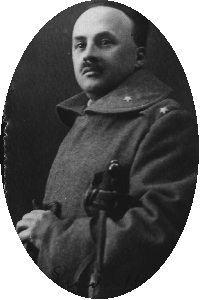
Guido Horn was born in Trieste in 1879 (the same year as Albert Einstein), from a jewish family. After his father's death he was brought up by his grandfather, Raffaele Sabato Melli, rabbi of Trieste. The particular atmosphere of Trieste, a town whose culture was deeply Italian despite its belonging to the Austrian Empire, has certainly influenced Guido's early years. Although he did not happen to know the many writers and poets born in Trieste (apart from poet Umberto Saba, whose antiquarian library he often visited), his culture was vast and his artistic interests included sculpture, music and literature.
Guido Horn and his brother Arrigo left Trieste to complete their education in Austria, first in Graz and then in Vienna, where he eventually got a degree in astronomy in 1902, with a doctoral dissertation about cometary orbits. Also the atmosphere of Vienna in the early twentieth century was an exciting one, or better, a revolutionary one: a revolution was going on in music, with dodecaphony, as well as in painting, with the Secession movement, and in other fields, such as psycoanalysis and theatre.
In 1903 Guido started to work at the Osservatorio
Mareografico in Trieste, then he passed to the astronomical observatory
of Catania and eventually to the astronomical observatory of Bologna.
 |
At 36 he volunteered in the First World War, leaving
his astronomical career to serve his true country, Italy; being a subject
to the Austrian Empire, he was under the constant risk of being arrested
and execute for desertion. Therefore he changed his surname into an Italian
one, d'Arturo, after his father name (and maybe also after the star Arcturus).
After the war, he kept this name and added it to Horn.
|
Guido became director of Bologna Observatory in 1921 and began to teach astronomy at the University. In 1926 he made a successful expedition to Oltregiuba (the modern Somalia) in order to observe the solar corona during a total solar eclipse; his theory about stellar scintillation was to be confirmed thirty years later by the Perkins Observatory.
Guido Horn d'Arturo made great efforts to renew the instrumentation of the Bologna Observatory, building a modern telescope (a Zeiss reflector of 60 cm) in the nearby town of Loiano and starting a project of his own, the mosaic mirror telescope. Father of the new telescope of the Keck Observatory, Horn's instrument was started in 1932 as an attempt to avoid the difficulties to build large mirrors by fusion. He created a mirror composed by exagonal elements and improved it during the years, reaching the diameter of 180 cm.
In 1938 the racial laws imposed by the Italian government forced Guido Horn d'Arturo to leave the chair of Astronomy, the direction of the observatory and his very house. Seven years later, after the end of the War, he was luckily reintegrated into his former position.
Another important realization by Guido Horn d'Arturo was the magazine Coelum, founded in 1931 and directed by him until his death. Coelum was the first Italian magazin of popular astronomy. He always intended to improve the reader's knowledge in astronomy, not to make astronomy trivial, so the level of Coelum was always a high one; Italian astronomers such as Livio Gratton, Giovan Battista Lacchini, Piero Tempesti and Paolo Maffei used to write articles on Coelum.
In 1921 Horn d'Arturo also started the Pubblicazioni dell'Osservatorio Astronomico Universitario, which were exchanged with the publications of astronomical observatories all over the world.
Guido Horn d'Arturo (a friend of the bolognese
painter Giorgio
Morandi) died in 1967, but he still lives in the memory of his family
and his old pupils; his name has been given to an asteroid, to a telescope,
to an amateur astronomy association and now also to the Astronomy Library
of Bologna.